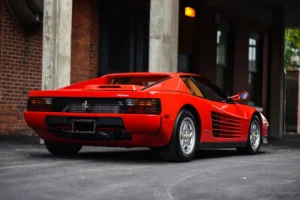What happens when you take a simple, everyday product like water, package it in a tall aluminum can with heavy metal-inspired branding, and give it an edgy, viral marketing campaign? If you’re Mike Cessario, the answer is Liquid Death, a $1.4 billion brand that has disrupted the bottled water industry by making hydration cool, rebellious, and sustainable.
From a Warped Tour inspiration in 2009 to a massive market disruptor, Liquid Death has captivated a young, environmentally-conscious audience with its bold branding and eco-friendly mission. This article explores Liquid Death’s journey, its unique marketing approach, and how it became one of the most talked-about beverage brands in recent years.
How a Music Festival Inspired a Multi-Billion Dollar Brand
Liquid Death’s story begins in 2009 at the Vans Warped Tour, a festival known for its punk and alternative music scene. Mike Cessario, then working in advertising, noticed that most musicians and festivalgoers were drinking water—not beer or energy drinks—but in plastic bottles. This observation sparked an idea:
What if water was packaged in a tall, beer-style aluminum can?
The vision wasn’t just about aesthetics; it was about creating a cultural shift. Cessario realized that young consumers were drawn to bold, rebellious branding, but no one had applied that strategy to bottled water.
From Concept to Brand: The Early Years
Cessario officially registered the Liquid Death name in 2017, testing the idea through a fake commercial that he launched online. The response was overwhelmingly positive, confirming that there was a market for an anti-establishment water brand.
By 2019, after two years of development and securing initial funding, Liquid Death was officially launched, introducing its first product: 100% mountain water in recyclable aluminum cans, with the slogan “Murder Your Thirst.”
What Makes Liquid Death Different?
Branding That Breaks the Mold
Unlike traditional bottled water brands, which emphasize purity, nature, and health, Liquid Death took an entirely different approach. Its branding is aggressive, rebellious, and unapologetically edgy, with elements inspired by punk rock, heavy metal, and skateboard culture.
Key branding elements include:
• Tall aluminum cans that resemble craft beer or energy drinks.
• Gothic typography and skull motifs.
• A dark, humorous marketing voice that satirizes corporate culture.
This anti-establishment approach helped Liquid Death stand out in an oversaturated bottled water market, attracting a loyal following among younger consumers who resonated with its irreverent style.
Sustainability at Its Core
Beyond the edgy branding, Liquid Death’s eco-conscious mission has been a significant factor in its success. The brand emphasizes that plastic waste is one of the biggest environmental threats, promoting its use of 100% recyclable aluminum cans as a sustainable alternative to plastic water bottles.
• Plastic vs. Aluminum: Unlike plastic, which often ends up in landfills or oceans, 75% of all aluminum ever produced is still in use today.
• Corporate Responsibility: The brand donates a portion of its profits to nonprofits fighting plastic pollution and environmental conservation efforts.
By combining sustainability with a rebellious attitude, Liquid Death made eco-consciousness cool and marketable.
Viral Marketing and Social Media Dominance
Liquid Death’s marketing strategy is arguably its greatest weapon. The brand leverages social media, humor, and viral content to create a strong online presence.
Some standout marketing tactics include:
• Hilariously extreme ad campaigns (e.g., hiring a witch doctor to curse its competition).
• Sponsoring punk and metal bands, reinforcing its connection to alternative music culture.
• Collaborations with celebrities and influencers, such as Tony Hawk, who even signed a limited-edition skateboard infused with his own blood for a promotion.
The brand’s social media strategy is less about traditional advertising and more about creating shareable, meme-worthy content, ensuring its name spreads organically.
Liquid Death’s Explosive Growth and Market Impact
A $1.4 Billion Brand Built on Disruption
Since its official launch in 2019, Liquid Death has seen rapid growth, securing major distribution deals with Whole Foods, Target, and 7-Eleven. The brand’s success has been fueled by:
• Expanding beyond water, introducing flavors like Severed Lime, Mango Chainsaw, and Berry It Alive.
• Launching “Liquid Death Iced Tea”, further diversifying its product lineup.
• Entering major sporting events and music festivals, positioning itself alongside established beverage giants.
Liquid Death’s unconventional approach has paid off, transforming it into a $1.4 billion brand within just a few years.
Competing with Beverage Industry Giants
Liquid Death’s success poses a significant challenge to traditional bottled water brands like Dasani, Evian, and Smartwater. It has also caught the attention of energy drink companies like Red Bull and Monster, given its similar visual appeal and brand energy.
The brand’s ability to convert consumers who typically buy plastic-bottled water has created a major disruption in the beverage market, forcing larger companies to rethink their packaging and marketing strategies.
Liquid Death’s First Super Bowl Commercial: A Major Milestone
As reported by Michael Fine, Liquid Death is set to air its first-ever Super Bowl commercial, marking a significant milestone for the brand. The Super Bowl, one of the most-watched televised events in the world, represents a major step in Liquid Death’s transition from a cult favorite to a mainstream powerhouse.
What can fans expect?
• Dark humor and satirical storytelling, staying true to Liquid Death’s brand identity.
• A high-budget production, signaling its status as a serious competitor in the beverage industry.
• Mass exposure, introducing the brand to millions of potential new customers.
By securing a Super Bowl ad spot, Liquid Death proves that a niche, rebellious brand can achieve mainstream dominance without compromising its identity.
The Future of Liquid Death
Looking ahead, Liquid Death shows no signs of slowing down. The brand continues to:
• Expand its product line, including new flavors, sparkling options, and teas.
• Push sustainability efforts, aiming to reduce plastic waste in the beverage industry.
• Innovate its marketing strategies, staying ahead of competitors through viral content and cultural relevance.
As consumers increasingly seek sustainable choices and alternative branding approaches, Liquid Death stands as a model of how creativity, disruption, and environmental consciousness can reshape an entire industry.
Final Thoughts: The Power of Branding and Innovation
Liquid Death’s meteoric rise proves that even the most ordinary product—water—can become a billion-dollar brand with the right combination of bold branding, sustainability, and cultural insight.
From a Warped Tour inspiration to a Super Bowl ad, the brand’s journey underscores the importance of challenging industry norms and thinking outside the box.
Liquid Death isn’t just a beverage—it’s a movement, and as long as consumers crave authenticity, sustainability, and creativity, it will continue to thrive.
No comments yet.







